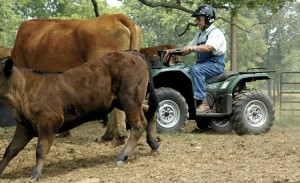ATV Safety on the Farm
go.ncsu.edu/readext?400194
en Español / em Português
El inglés es el idioma de control de esta página. En la medida en que haya algún conflicto entre la traducción al inglés y la traducción, el inglés prevalece.
Al hacer clic en el enlace de traducción se activa un servicio de traducción gratuito para convertir la página al español. Al igual que con cualquier traducción por Internet, la conversión no es sensible al contexto y puede que no traduzca el texto en su significado original. NC State Extension no garantiza la exactitud del texto traducido. Por favor, tenga en cuenta que algunas aplicaciones y/o servicios pueden no funcionar como se espera cuando se traducen.
Português
Inglês é o idioma de controle desta página. Na medida que haja algum conflito entre o texto original em Inglês e a tradução, o Inglês prevalece.
Ao clicar no link de tradução, um serviço gratuito de tradução será ativado para converter a página para o Português. Como em qualquer tradução pela internet, a conversão não é sensivel ao contexto e pode não ocorrer a tradução para o significado orginal. O serviço de Extensão da Carolina do Norte (NC State Extension) não garante a exatidão do texto traduzido. Por favor, observe que algumas funções ou serviços podem não funcionar como esperado após a tradução.
English
English is the controlling language of this page. To the extent there is any conflict between the English text and the translation, English controls.
Clicking on the translation link activates a free translation service to convert the page to Spanish. As with any Internet translation, the conversion is not context-sensitive and may not translate the text to its original meaning. NC State Extension does not guarantee the accuracy of the translated text. Please note that some applications and/or services may not function as expected when translated.
Collapse ▲ When all-terrain vehicles (ATVs) first appeared in the United States in the 1970s, they were promoted and sold as a recreational vehicle designed to provide “thrills” for the rider. Sport and recreation operators found that the ATV was a useful machine to move through areas not accessible with pick-up trucks, four-wheel drives or other motorized vehicles, and the ATV became a popular hunting vehicle.
When all-terrain vehicles (ATVs) first appeared in the United States in the 1970s, they were promoted and sold as a recreational vehicle designed to provide “thrills” for the rider. Sport and recreation operators found that the ATV was a useful machine to move through areas not accessible with pick-up trucks, four-wheel drives or other motorized vehicles, and the ATV became a popular hunting vehicle.
The ATV has also found many uses in agriculture as a substitute for pick-up trucks, horses, and, even walking. The ATV is now found on all types of farms and ranches, in orchards and forests, in ornamental nurseries and on golf courses.
ATVs are used to inspect crops and livestock; to inspect and repair irrigation systems and fence lines; to fertilize and apply chemicals; to supervise field crews; to herd livestock; to mark timber; to mow grass; to move dirt; and to transport things from here to there and back again.
Handling and moving cattle can be done from horseback, on foot, or with the use of an all-terrain vehicle. When using an ATV, scan ahead and to the side for obstacles, uneven terrain, vehicles, people, and animals. Reduce your speed. Pay attention to hazards such as guy wires and barbed wire fences; they are low profile and difficult to see. When gathering livestock, the ATV rider often concentrates more on the animals than on the terrain. Failure to watch changing terrain or to look for unexpected obstacles can lead to a serious injury. Loose wire lying in a pasture, in brush, or on vines can pull feet from footrests, resulting in an injury. Tall grass in pastures can hide such obstacles as holes, stumps, and rocks from a rider’s view.
For safety, it is essential to keep the ATV in good condition. Perform a pre-trip inspection before riding the ATV and institute a preventive maintenance program. Be aware of the turning and maneuvering space needed for the ATV.
Introduce the ATV slowly to cattle. Their first experiences should be positively associated with a handling activity such as feeding. Many people do not realize that cattle’s behavior during handling is affected by previous experiences. Placing the ATV in a field or pen will attract the animals and allow the animals to approach, poke, and sniff. Understanding the concepts of flight zone and point of balance described earlier will enable you to use the ATV to handle livestock safely.
Rough handling can cause cattle to be wilder and have more stress than cattle that are handled calmly. Certain individual cattle within a herd may have an excitable temperament and become very agitated. The animals with an excitable temperament should be culled because they are likely to injure other animals or workers.
The hazards that are involved with using ATVs can get really hairy, but with the proper personal protective equipment, the potential for an injury is reduced greatly. A helmet with a face shield should be used. Approved gloves should be used, along with long pants, long-sleeve shirts and the clothing should fit but not be loose which could catch on branches or fences. Boots or shoes that reach above the ankle should be worn and heels / soles should be slip-resistant.




